Friday 11th May 1979, Crystal Palace beat Burnley 2-0 at
Selhurst Park in front of a record crowd of 51,482 fans. That secured promotion to the First Division
(now the Premier League). They only
needed a point to confirm promotion, but the win ensured they would end up as
Second Division Champions.
This prompted the prophesy from ex-footballer-turned-pundit,
Jimmy Greaves to label them ‘The Team of
the 80’s’.
This may be the first time you’ve
heard of Crystal Palace being the Team of the 80’s and there’s a reason for
that, as things didn’t really turn out as anticipated.
It had been an impressive journey
and Eagles fans had much to confident of.
Much of their positivity was down to an astute youth policy which was
beginning to take shape.
Palace were managed by Terry Venables. Venables had joined the club as a player in
1974 and took the opportunity to move into coaching under then manager, Malcolm
Allison.
In 1975/76 they were a Third Division club but had reached the FA Cup Semi-Finals, only to lose to eventual winners, Southampton. That defeat seemed to knock them off their stride in their attempt to gain promotion too, as they won just 1 of their 7 league matches following the Semi-Final to fall from 2nd to 5th. Allison left and Venables took over. The FA Cup wasn’t the only aspect of notoriety they had earned as Peter Taylor was selected to play for England, despite playing in the Third Division.
In 1975/76 they were a Third Division club but had reached the FA Cup Semi-Finals, only to lose to eventual winners, Southampton. That defeat seemed to knock them off their stride in their attempt to gain promotion too, as they won just 1 of their 7 league matches following the Semi-Final to fall from 2nd to 5th. Allison left and Venables took over. The FA Cup wasn’t the only aspect of notoriety they had earned as Peter Taylor was selected to play for England, despite playing in the Third Division.
1976-77 was an
important season for the club. They
gained promotion to the Second Division, beating Rotherham on goal difference,
but also won the FA Youth Cup, beating Everton, 1-0 after 2 legs. Palace’s side included 4 players who would
form the cornerstone to their success over the coming years – Kenny Sansom, Terry Fenwick, Billy Gilbert
and Jerry Murphy. Sansom went onto become the most capped left
back for England, until Ashley Cole came along.
Fenwick was a tough tackling centre-back who played in and FA Cup Final
and also in the World Cup for England.
Gilbert played over 200 times for Palace and so did Murphy, who was a cultured
passing midfield player. Up front they
relied on the goals of Ian Walsh who was one of the youngest in the squad. Palace’s route to the Final had been
entertaining, especially given their 8-0 win over Spurs in the
Semi-Finals. Terry Fenwick scored the
winning goal in the Final against an Everton side who included future stars as
Kevin Ratcliffe, Steve McMahon and Joe McBride.
1977-78 Palace
finished 9th in the Second Division, although that would appear they
were within a shout of promotion at one point, the truth is they were only 4pts
ahead of Blackpool who were relegated.
In the Youth Cup, they became only
the third club to retain the trophy. By
this time 5 of the squad were regular members of the first team squad. Players such as Peter Nicholas and Vince
Hilaire were really starting to make an impression, and Steve Lovell and Steve MacKenzie were also showing real promise. Hilaire, a pacy winger, had made his debut in
the first team as a 17 year old against Lincoln in March 1977. He quickly became a crowd favourite, although
being a black player meant he also copped much of the racist abuse around at
the time. In the Final they were up
against Aston Villa in the Final and once again it was Fenwick who scored the
winning goal. That Villa side contained
4 players who would play a part in the club’s League and European Cup success
in 1981 and 1982, Gary Shaw, Colin Gibson, Gary Williams and Brendan Ormsby.
Palace’s achievement at youth
level was now to be ranked alongside the Manchester United Busby Babes side of
the mid-50’s and Chelsea in 1960 and 1961 which went onto League Cup and FA Cup
over the next ten years.
1978-79 had been a
season where things really started to click into place. Palace topped the table at Christmas but were
beaten at home by Bristol Rovers on Boxing Day.
They then drew the next 5 matches, before improving things with 4 wins
in the next 6 games. They were on a run
of 12 games unbeaten before losing at Newcastle at the beginning of April, but
not to be deterred, they put on one final burst to win 5 of their last 7
matches to take the title.
Palace’s defence was the key to
their success, conceding just 24 goals in their 42 matches, including just 2 in
their final 7 games. Venables had signed
John Burridge from Aston Villa and
he proved to be an outstanding purchase.
Burridge had won a League Cup winners medal with Villa in 1975, and at
27 was one of the oldest players in the team and so brought some vital
experience. It’s fair to say Palace may
have remained in the Second Division if they hadn’t signed ‘Budgie’.
Burridge was one of 2 players
Venables signed who added some much needed experience to his young side. Steve
Kember. Born in Croydon, Kember had
begun his career at Palace as an apprentice spending 6 years there including a
spell as club captain. He moved to
Chelsea in 1971 and then onto Leicester, before Venables brought him back to
Selhurst Park.
After the title was secured against
Burnley when Ian Walsh and Dave Swindlehurst scored, Venables set
about building his squad to cope with the rigours of First Division football.
In the summer Venables made two shrewd
moves in the transfer market. Gerry Francis was captain of a Queen’s Park
Rangers side who came within a point of winning the League title in 1976. He also captained England 8 times before
joining Palace in July 1979 for £465,000.
Mike Flanagan had
spent 8 seasons at Charlton forging a dangerous strike partnership with Derek
Hales. He’d spent the summer in the NASL
and was voted Most Valuable Player (MVP) in a league which included the likes
of Rodney Marsh, George Best, Franz Beckenbauer, Trevor Francis. Venables signed him for £650,000.
1979-80
The opening game of the 1979-80
season saw Palace travel to Manchester
City, who were now managed by former Eagles boss, Malcolm Allison and
contained one of their FA Youth Cup winning players, Steve MacKenzie. Allison had paid Palace £250,000 which made
MacKenzie the most expensive teenager in English football at that time. MacKenzie was just one of a host of big money
signings Allison had made in a bid to return City to the success of the late
60’s and early 70’s, but it was to backfire alarmingly.
Palace earned a creditable 0-0 draw and proved hard to score against as they conceded
just 2 goals in their opening 6 matches.
After further draws against Southampton
(0-0) and Middlesbro
(1-1) they picked up their first win of the season as they
thrashed Derby, 4-0. Derby contained
experienced players such as Roy McFarland, Dave Webb, Gordon Hill Gerry Daly
and Bruce Rioch, but Palace put them to the sword with goals from Nicholas,
Swindlehurst and a brace from new signing, Flanagan.
In the League Cup they thrashed Stockport, 7-0 with
goals from Murphy, Francis, Flanagan (2), Walsh (2) and Hilaire. The result flattered Palace as Stockport’s
keeper had been injured and they’d used their sub.
After a 1-1 draw at Wolves,
they then won their next 3 matches to put them top of the table. Aston
Villa (2-0), Stoke City (2-1) and Ipswich (4-1) were
all swept aside, and for the one and only time in their history, Crystal Palace
sat on top of the English First Division, albeit on goal difference, but top
nonetheless. They were also unbeaten and
one of just 2 clubs who could make that claim at that stage of the season (4th
Division Walsall being the other).
The Ipswich performance was
certainly one to remember. Ipswich, FA
Cup winners in 1978 and a team who were to come within a whisker of winning the
league in 1981. They were packed full of
internationals - Mariner, Osman, Mills, Butcher (England), Brazil, Wark, Burley
(Scotland) and of course, Thijssen and Muhren (Netherlands). Palace were ruthless. Swindlehurst scored his 4th of the
season, Francis, his first for the club and even a rare goal from full-back,
Paul Hinshelwood. But it was the goal
from the captain which brought the place to their feet. A cross from the left by Flanagan found Jim
Cannon in the box and he thumped it home.
4-1 against, what was to become, one of the best sides in Europe, and
that added benefit of sitting on top of the pile.
October
Such was the excitement around the
club that over 45,000 packed into Selhurst Park for the visit of Tottenham. Ian Walsh opened his account for the season,
but the 1-1 draw saw Palace drop to 3rd as United and
Forest moved above them. Palace fans
weren’t to realise at the time, but the Ipswich result marked a point where it
wouldn’t get any better.
The first defeat of the season
came at The Dell against Southampton. Full back, Paul Hinshelwood scored again, but
a hat-trick from Phil Boyer helped Southampton to a 4-1
win. Worse was to follow as they went to
Goodison Park and were beaten 1-3 by Everton. They managed to stop the rot with draws
against Bristol City and Bolton, although as both clubs
eventually were relegated, Palace should’ve been expecting more. Goals from Swindlehurst had dried up and
Flanagan had only scored in 2 games.
November
But November began with
back-to-back home wins against Man City
and Arsenal was then followed by a
very creditable 1-1 draw at Old Trafford
against League leaders, Man Utd. Swindlehurst scored in all three matches and
Palace were 3rd just a point off the leaders, Liverpool. But Palace managed just 1 goal in the next 5
games, although that was another highlight as Nottingham Forest, League champions in 1978 and current European
Cup holders, came to Selhurst Park and Ian Walsh grabbed the only goal of the
game. The goal was synonymous with much
of Palace’s play that season. Hilaire
bursts through on the counter attack, finds Walsh on the right, he cuts inside
and beats Shilton on the near post. A
rare error from Shilton, but few could dispute the energy in the home side’s
football.
For many fans, the trip to Anfield
on 15th December was significant.
Liverpool were the reigning
League champions and top of the table again, albeit only 3pts ahead of
Palace. Palace held them until just
before the break when Jimmy Case put the home side ahead. Just after half-time, Kenny Dalglish doubled
the lead and then Terry McDermott made it 3-0. Many Palace refer back to this game as a
turning point, in that Palace seemed completely deflated after this and never
recovered.
Having lost 0-3 to the leaders, they then went down by the same score to 2nd-from-bottom,
Brighton. Brighton had come up with Palace the previous
season, yet the two had experienced completely different fortunes, although the
highlight for Brighton was ending Forest’s 42-game unbeaten run. Palace were unfortunate to have met Brighton
at the time of a rare rich vein of form but the defeat was one of 3 in a row,
and when they were held at home by Norwich on New Year’s Day, Palace were now
on a run of 1 win in their last 8. During that run their unbeaten home record
went when Middlesbrough won 2-1 during the Christmas period. Palace had now dropped to 11th
place.
January
The FA Cup represented a tricky
one for Palace, as they were now a First Division side and there to be shot
at. They were up against Second Division
Swansea City, and the two hadn’t met for 15 years. They tried to make up that time by playing
three times as The Swans won 2-1 in a 2nd
Replay at Selhurst Park.
Ian Walsh scored 2 goals to beat Derby and Mike Flanagan scored the only
goal of the game to beat Wolves. That was Flanagan’s first goal since October,
but more alarmingly Swindlehurst had still failed to find the net and that was
largely Palace’s problem. Swindlehurst’s
goal at Old Trafford in November was his 7th of the season and he’d
then scored almost a third of his side’s goals.
But that was it, he didn’t find the net for the rest of the season and
his team struggled. In fact, between
that United game in November and the end of February, Palace scored in just 5
of their 13 matches, and won just 3 games.
But Palace had got enough in the bank from their early season form and
when Everton arrived at Selhurst
Park in February they were pleased to just come away with a point as they were
hovering dangerously close to the relegation places.
March
Two of the clubs in the relegation
zone, Bristol City and Bolton, were then beaten by
Palace. The lowest crowd of the season
turned up at Selhurst Park to see the visit of Bolton, who’d won just 2 games
all season, neither of which were away.
Palace won 3-1 with goals from
Murphy, Hilaire and the only one of the season from centre-back, Billy
Gilbert. Palace were now up to 7th
and may even have begun to dream about Europe, but this was the last time they
scored more than once in a game that season and only scored in 5 of their final
10 matches. Interesting to note that 3
of their last 6 goals came from defenders, with even Kenny Sansom getting on
the scoresheet at Arsenal. Sansom only scored 3 goals in his Palace
career so those who witnessed it were lucky, and it got over the memory of
Francis missing a penalty too. The
penultimate game of the season was in front of the largest crowd at Selhurst as
Liverpool were the visitors. Palace held the League champions and current
League leaders to a 0-0 draw. It was the 9th draw at home for
The Eagles and they could be proud that just 4 other teams conceded fewer goals
at home that season.
Palace’s final game of the season
was at Nottingham Forest. Forest were just back from a game in
Amsterdam where they secured their 2nd successive European Cup Final
place, and were still buzzing when they saw off Palace, 4-0. It left Palace
finishing in 13th position, which was certainly not an
embarrassment. Much was in evidence
which could be built upon, but what happened next shocked everyone and then
club was never the same again.
Palace had been beaten just 3
times at home and only 3 other clubs, Liverpool, Man Utd and Nottingham Forest,
could boast records better than that.
But it was the lack of goals which hurt them. 41 in a 42-game season was only better than
Bristol City (37) and Bolton (38) and they both went down. However, they had proved to be hard to beat.
1980-81
Clive Allen made his
debut for QPR at home to Coventry in April 1979, a month short of his 18th
birthday. He scored a hat-trick on his
debut and was announced loud and clear to the world. QPR were relegated that season and in Division
Two the following season, Allen hit 28 goals as Rangers narrowly missed out on
coming straight back up. For Allen,
though, things were about to go big.
Several First Division clubs had been watching his progress and Arsenal
manager, Terry Neill was the one who got the chequebook out and paid £1.25m to
QPR, which was a record for a teenager at the time. Arsenal had just missed out on winning the
European Cup-Winners’ Cup by losing in a penalty shootout to Valencia. Allen was the hottest young property in
football at that time, and Neill clearly thought he was buying for the future.
Allen took part in 3 of Arsenal’s
pre-season friendlies in 1980. Terry
Neill then set about replacing his ageing left back, Sammy Nelson. The most promising young full back at the
time was Palace’s Kenny Sansom. Neill
put in a bid of £1m for the 21 year old, but in the end some wheeler-dealing
was done, Neill offered Allen and a promising young goalkeeper, Paul Barron and in return got Sansom
and £400,000.
Kenny Sansom went onto become
England’s most capped left back, until Ashley Cole recently went past him. He could arguably be considered the best
player to have ever played for Palace.
Did they get the money they deserved?
Who knows, but Allen and Barron were certainly promising young players.
The season began with the toughest
fixture of them all in those days, a trip to the champions Liverpool. Paul Barron started
in goal for Palace and the other new boy, Clive Allen started a partnership
Mike Flanagan which had the headline writers licking their lips. Flanagan and Allen being a famous double act
from war time Britain.
Kenny Dalglish and Ray Kennedy
gave Liverpool a 2-0 lead at half-time and Alan Kennedy rounded off the scoring
in the last 10 minutes and Liverpool had matched their 3-0 win over Palace at the same venue the previous season. Palace then entertained Tottenham at Selhurst Park.
Spurs had also been in the transfer news in the summer, signing a new
strike partnership in Garth Crooks and Steve Archibald. Both scored to give Spurs a 2 goal lead,
before Vince Hilaire got a goal back.
Hoddle then restored the visitors 2 goal lead, before Neil Smillie
brought the home side back in it. Then a
bizarre incident when Crooks fouled Hilaire, who stood up and pushed the first
person he saw which happened to be the referee.
Needless to say, Hilaire got sent off and Spurs then made it 4-2 before
Jim Cannon got a goal back. Spurs
eventually won a classic encounter 4-3. Quite a baptism of fire for the new young keeper,
picking the ball out of the net 7 times in just 2 matches.
You certainly got your money’s
worth in goals where Palace’s early season form was concerned. A Clive Allen hat-trick gave them an
impressive 5-2 win over Middlesbrough as Tony Sealy and Gerry
Francis also scored. 17 goals from 3
Palace matches already and you couldn’t accuse them of being boring. Then it all turned sour.
September
Victory over Bolton in the League Cup masked the atmosphere around the
club. Chairman Ray Bloye had done a deal
with Sainsbury’s to build a store at the Whitehorse Lane End of Selhurst
Park. Apparently this lead to a strain
in the relationship between chairman and manager. Then Palace were involved in controversy on
the pitch when they travelled to Highfield Road to meet Coventry City. Clive Allen
took a free-kick from outside the area and it hit the stanchion inside the goal
and came straight back out again. The
referee consulted his linesman and they both agreed the ball had hit the post
and bar and bounced out, but replays clearly showed the ball was inside the
goal. Palace lost 1-3 and that game was the 2nd of a run of 7
straight defeats. They only scored in
two of those games as well.
October
14th October 1980,
three days after a 0-1 defeat at Sunderland leaving them rock bottom of
the First Division having lost every game except the Middlesbrough win, a
bombshell was dropped over the club.
Terry Venables left.
There are rumours of the chairman
approaching other managers with a view to replacing Venables, but many fans
still feel let down by him. He had built
this team after Malcolm Allison left and they truly believed they could build
on their first season back in the top flight.
Now they were bottom of the table and without their charismatic and
talismanic figurehead. Oddly, Venables
then took up the manager’s position at QPR, who were languishing 12th
in Division Two which didn’t endear him any further to Eagles fans.
Long-serving coach, Ernie Walley took over temporary charge
of the team and they seemed immediately galvanised. Wins over Leicester and Southampton
(including a Mike Flanagan hst-trick) and a draw at Norwich gave them some much needed points, then at the beginning of
November they beat Manchester United, 1-0 at home thanks to a brilliant goal from Peter Nicholas who
delicately curled his shot over Gary Bailey.
They were now 3rd from bottom having picked up 7pts from a
maximum 10.
Further defeats at Birmingham and Tottenham was then followed by a spirited display against Liverpool at Selhurst. In an eventful game, Phil Thompson broke his
collarbone in a collision with Ray Clemence, and Palace’s keeper Paul Barron
suffered mild concussion from a whack on the head. An own goal from Avi Cohen and a penalty from
Gerry Francis had threatened to win it for Palace after they’d gone behind, but
Terry McDermott scored a disputed goal to leave the game level.
December
Into December and the return of Malcolm Allison, who’d been sacked by
Manchester City. At the same time Ron
Noades was negotiating a deal to buy the club from Ray Bloye, Allison sold John
Burridge, Mike Flanagan and Terry Fenwick to QPR where they joined their old
boss, Venables. There are various
concerns about the money received by Palace for these players, and the fact
that Venables and Allison were old mates didn’t help the conspiracy theorists,
Again Palace won their first match
under a new manager when they beat Norwich 4-1 at
home. Allen bagged another couple, with
Murphy and Francis also scoring. But the
year ended with a defeat away to their bitterest rivals, Brighton (2-3) and Palace were
back at the foot of the table.
January
January begun with a defeat in the
FA Cup at Manchester City. Although the 0-4 defeat
was disappointing, City went onto to lose the Final in a replay so at least
Palace had lost to the 2nd best side in the competition that
year. Of course for Allison he was
beaten by a better side than the one he’d left behind at Maine Road.
Back in the League they earned
draws at home to Stoke and Wolves but then lost the next 7
games. During February, Ron Noades
completed his takeover and then appointed Dario
Gradi as new manager, and he became the 4th manager that season
to take charge of the team. Gerry
Francis then joined the Palace exodus to Loftus Road.
February was a disastrous month as
they lost all four league matches, Ipswich (2-3), Coventry (0-3),
Aston Villa (1-2), Everton (2-3).
March
In March Peter Nicholas moved to
Arsenal in a deal which saw David Price come the other way and gradually the
Team of the 80’s had been broken up.
That great side which won the Youth Cup was now spread around the rest
of the division. On 4th April
they travelled to Old Trafford knowing defeat would see them return to Division
Two. They’d gone 14 games since their
last victory and only picked up 1pt from their last 9 games. United
won 1-0 and Palace’s dream of glory had come to a sorry and sudden
end.
They then beat Birmingham, 3-1 in
front of the lowest attendance at Selhurst since 1968, before losing again to Brighton, Arsenal and Nottingham Forest. Palace finished bottom of the table, 16pts
adrift of safety with just 19pts then a record low for the First Division. The knife was pushed in further as it was
Brighton who finished 4th from bottom and so stayed up.
It had been a roller-coaster ride
and one few would ever forget. Of the
side which came up in a blaze of glory two season previous, only Gilbert,
Hinshelwood, Cannon, Murphy and Hilaire remained. Although Hilaire had put in a transfer request
earlier in the season. QPR were waiting
for them in Division Two the following season as Palace finished just 4pts away
from a 2nd successive relegation.
It would be 8 seasons before the Selhurst Park faithful would see top
flight football again.
Managers
Terry Venables
Ernie Whalley
Malcolm Allison
Dario Gradi
Goalkeepers
John Burridge
Paul Barron
David Fry
Defenders
Paul Hinshelwood
Kenny Sansom
Billy Gilbert
Jim Cannon
Terry Fenwick
Ian Evans
Terry Boyle
Midfield
Jerry Murphy
Peter Nicholas
Gerry Francis
Vince Hilaire
Steve Kember
David Price
Neil Smillie
Strikers
Dave Hinshelwood
Ian Walsh
Clive Allen
Mike Flanagan
Steve Lovell
Steve Leahy
Mike Elwiss
Tony Sealy

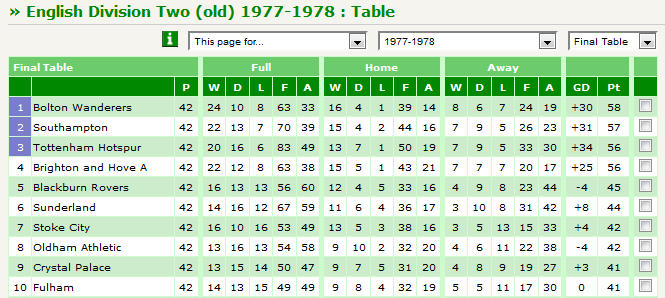
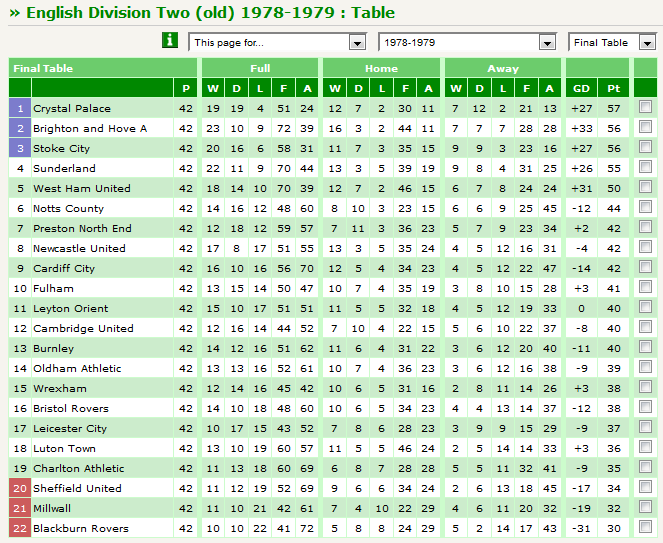

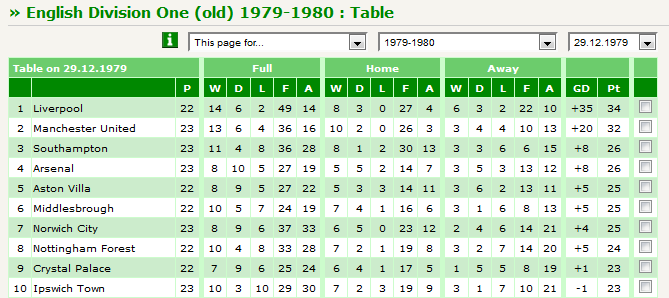
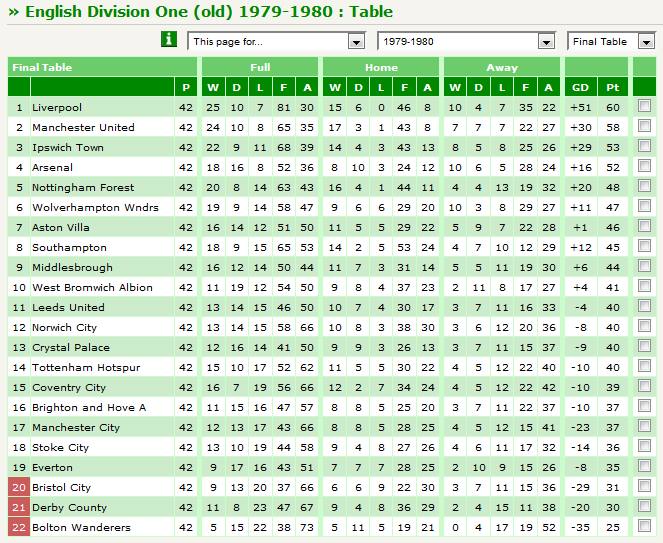

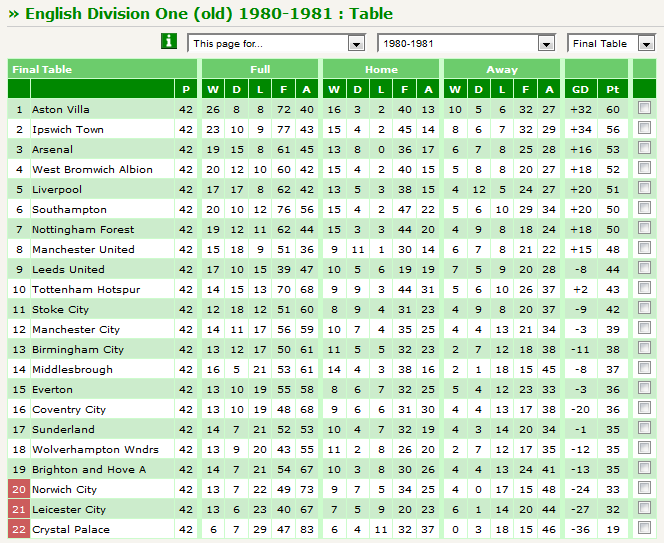
No comments:
Post a Comment